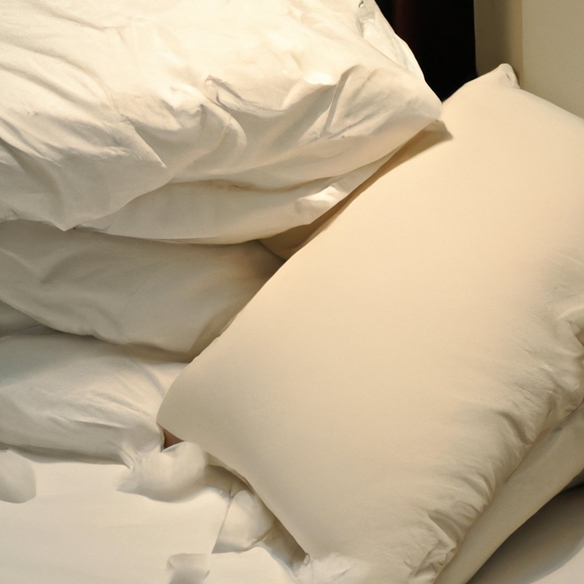Guide to Replacing Pillows and Duvets
According to experts, physical and mental health depends on a good night’s sleep. Optimizing your bedroom environment and bedding can improve your sleep quality. Maintain your pillow and replace it when necessary to ensure that it always provides you with the right amount of support.
We spend so much time in bed with our heads resting on our pillows that it is essential to pay attention to the quality and cleanliness of our pillows. If you don’t change your pillows regularly, you might develop allergic reactions, breakouts, and neck pain. Let’s talk about taking care of your pillow & duvet and when it’s time to buy new bed linen sets.
Why Replace Pillows and Duvet?

In addition to being a hassle, replacing pillows and duvets frequently can lead to allergies, skin breakouts, and sore muscles.
The dust mites, mould, fungi, and pet dander accumulated on an old pillow may cause allergies. Some people suffer from runny or stuffy noses, itchy skin, and irritated eyes due to sleeping near those allergens. If you suffer from allergies to pillows, it is advisable to replace them often or buy antimicrobial and breathable pillows.
Oils from your face and hair, sweat, drool, and other dirt can also seep through pillowcases and get trapped inside your pillows, leaving yellow stains on them. These substances may clog your pores and cause acne breakouts or rashes if you have sensitive skin. A mild detergent should be used frequently to wash pillowcases and pillows and to avoid irritants, pillowcases and pillows should be replaced often.
When to Replace your Pillows?

A brand-new set of pillows offers luxurious, plump comfort and a fresh, clean aroma that all of us love.
After years of continued use, pillows can begin to lose their supportive structure and cleanliness, potentially attracting dust mites and dead skin cells (yikes! ), which can negatively affect your health.
Don’t worry, there are several things you can do to keep your pillows in the best condition possible throughout their recommended two-year lifespan. As a first step, keep them plumped up daily to prevent sagging and evenly distribute the filling.
Also, you can use pillow protectors, which offer a protective barrier against dirt and oils – but be sure to wash and change your pillowcases and protectors weekly to maintain cleanliness.
It is also a great idea to wash your pillows from time to time. It is recommended that you wash most pillows every six months with a standard washing machine and tumble dryer to remove any dead skin cells and pesky dust mites that have made themselves at home in your pillow. Despite this, ensure you always check the care label for specific instructions regarding washing before you do.
You can test if your pillow needs replacing with an arm test to find out whether it’s time to replace it. Ensure the pillow is balanced over your arm; if it sags on either side, it must be replaced. As long as it remains reasonably rigid and holds its shape, it should be able to sleep for plenty more nights.
When to Replace Your Duvet?
When the filling isn’t evenly distributed or starts to come through the casing, you should replace the duvet.
Since your duvet rests on top of you at night, instead of taking on your weight, it should last longer than your pillows. According to the Sleep Council, a duvet should last at least five years, but
How to Make Your Duvet Last Longer?
In terms of bedding, you can expect your bedding to last longer when it is of high quality. When picking your duvet, it’s essential to research how it is made, as it can make a massive difference to how well you sleep at night.
It would be best to look for a cotton cover duvet that will make the duvet more breathable, keeping you more relaxed and the duvet cleaner.
Furthermore, a higher thread count case will make your duvet last longer by preventing feathers from escaping. 233 thread count is the minimum thread count we use for our duvet covers.
A Step-by-Step Guide to Clean Feather Pillows
Feather Pillows are a staple of cozy comfort, but they can also be a bit of a pain to clean. Feather dusters and dust mites can build up in your pillows and cause allergies or asthma. It’s important to regularly clean your luxury feather pillows to keep them fresh and clean for years to come.
- Remove all of the pillows from your bed and set them aside somewhere safe.
- Get yourself a vacuum with a brush attachment, or hire someone who has one and ask them for help with this step! You’ll want to thoroughly vacuum each pillow surface, making sure you get into all of the little nooks and crannies where dust likes to the hideout.
- Next up is washing time! Take your pillows down to the laundry room (or wherever else you wash things) and run them through a cold water cycle with some detergent on a gentle cycle – no need for hot water if they’re not heavily soiled! When they’re done washing, put them through another rinse cycle without any soap in it – just water will do the trick here! Let them hang dry overnight before returning.
- Remove the pillowcase and wash it in cold water with mild soap.
- Put the case through the rinse cycle twice to remove all traces of soap and dirt. Hang dry or lay flat to dry (this will take up to 72 hours).
- If you have allergies or asthma, wear rubber gloves when handling the pillowcase because they can cause an allergic reaction in some people.
- Fill your washing machine with cold water and add one cup of white vinegar or laundry detergent (choose whichever works best for your machine). Let the washing machine agitate for five minutes before adding your pillows; let them agitate for another five minutes before turning off the machine and opening its door so that any remaining water drains out completely
- Fill your sink or basin with cool water and add a small amount of mild detergent and one drop of dish soap (optional). Swirl the water around gently to mix it up, then soak the pillow in the solution for 30 minutes.
- After 30 minutes, remove the pillow from the sink, squeeze out any excess water, and lay it flat on a towel or drying rack so that all sides can air dry completely before putting it back in its case.
- If necessary, repeat this process until there are no more stains on your pillow!
Feather pillows are a great addition to any bedroom, but they can be a little more difficult to clean than your average pillow. Luckily, there’s a simple solution that keeps your feather-down pillows looking and feeling great for years to come.
Conclusion:
Remove the pillow from its cover and shake it vigorously to remove loose feathers or dust. If there is still some excess dust on the pillow, you can use your vacuum cleaner with a brush attachment or upholstery attachment to remove it. Use warm water and mild detergent or soap to clean the outside of the pillowcase and washcloth (if you used one) by hand or in the washing machine on a gentle cycle with cold water only if necessary! Be sure not to use hot water as it will damage the feathers inside of your pillowcase! Once washed, lay flat on a dry surface until completely dry before replacing into its case again.
If possible, air out your feather pillows outside in direct sunlight for several hours at least once every month during warmer seasons so that they don’t develop mould inside their cases over time due to moisture buildup after cleaning them regularly inside your home using hot water during colder seasons where temperatures tend not. Feather pillows are a great way to get a restful night’s sleep, but they can also be a pain in the neck when it comes time to clean them.



